By Jamie Dimon, chairman and chief executive of JPMorgan Chase
Dear Fellow Shareholders,
We are facing challenges at every turn: a pandemic, unprecedented government actions, a strong recovery after a sharp and deep global recession, a highly polarized U.S. election, mounting inflation, a war in Ukraine and dramatic economic sanctions against Russia. While all this turmoil has serious ramifications on our company, its effect on the world — with the extreme suffering of the Ukrainian people and the potential restructuring of the global order — is far more important.
Adding to the disruption, these events are unfolding while America remains divided within its borders, with many arguing that it has lost its essential leadership role outside of its borders and around the world. But during this difficult time, we have a moment to put aside our differences, offer solutions and work with others in the Western world to come together in defense of democracy and essential freedoms, including free enterprise. We have seen America, in partnership with other countries around the globe, come together previously during instances of conflict and crisis. This juncture is also a moment when our country needs to work across the private and public sectors to lead once again by, among other remediations, improving American competitiveness and better fulfilling equal access to opportunity for all. JPMorgan Chase, a company that has historically worked across borders and boundaries, will do its part to ensure the global economy is safe and secure. I discuss these themes later in this letter.
Although I begin this annual letter to shareholders in a challenging landscape, I remain proud of what our company and our hundreds of thousands of employees around the world have achieved, collectively and individually. As you know, we have long championed the essential role of banking in a community — its potential for bringing people together, for enabling companies and individuals to reach for their dreams, and for being a source of strength in difficult times. Throughout these past two challenging years, we never stopped doing all the things we should be doing to serve our clients and our communities.
Looking back on the last year and the past two decades — starting from my time as CEO of Bank One in 2000 — it is clear that our financial discipline, constant investment in innovation and ongoing development of our people are what enabled us to persevere in our steadfast dedication to help clients, communities and countries throughout the world. 2021 was another strong year for JPMorgan Chase, with the firm generating record revenue, as well as setting numerous other records in each of our lines of business. We earned $48.3 billion in net income on revenue of $125.3 billion versus $29.1 billion on revenue of $122.9 billion in 2020, reflecting strong underlying performance across our businesses. Included in the $48.3 billion is $9.2 billion after tax in reserve releases due to the volatility introduced by the new current expected credit loss accounting standard. We have pointed out repeatedly that we do not consider these reserve releases core or recurring profits because they are driven by hypothetical, probability-weighted scenarios. Excluding these reserve releases, we still earned 18% on tangible equity — an extremely healthy number. We generally grew market share across our businesses and continued to make significant investments in products, people and technology, all while maintaining credit discipline and a fortress balance sheet. In total, we extended credit and raised capital of $3.2 trillion for large and small businesses, governments and U.S. consumers.
I’d like to note some steadfast principles that are worth repeating. The first is that while JPMorgan Chase stock is owned by large institutions, pension plans, mutual funds and directly by individual investors, in almost all cases, the ultimate beneficiaries are individuals in our communities. More than 100 million people in the United States own stock, and a large percentage of these individuals, in one way or another, own JPMorgan Chase stock. Many of these people are veterans, teachers, police officers, firefighters, healthcare workers, retirees or those saving for a home, education or retirement. Your management team goes to work every day recognizing the enormous responsibility that we have to our shareholders.
Second, while we don’t run the company worrying about the stock price in the short run, in the long run our stock price is a measure of the progress we have made over the years. This progress is a function of continual investments in our people, systems and products, in good and bad times, to build our capabilities. Whether looking back 10 years or since the JPMorgan Chase/Bank One merger in 2004, these investments have resulted in our stock’s significant outperformance of the Standard & Poor’s 500 Index and the Standard & Poor’s Financials Index. These important investments will also drive our company’s future prospects and position it to grow and prosper for decades.
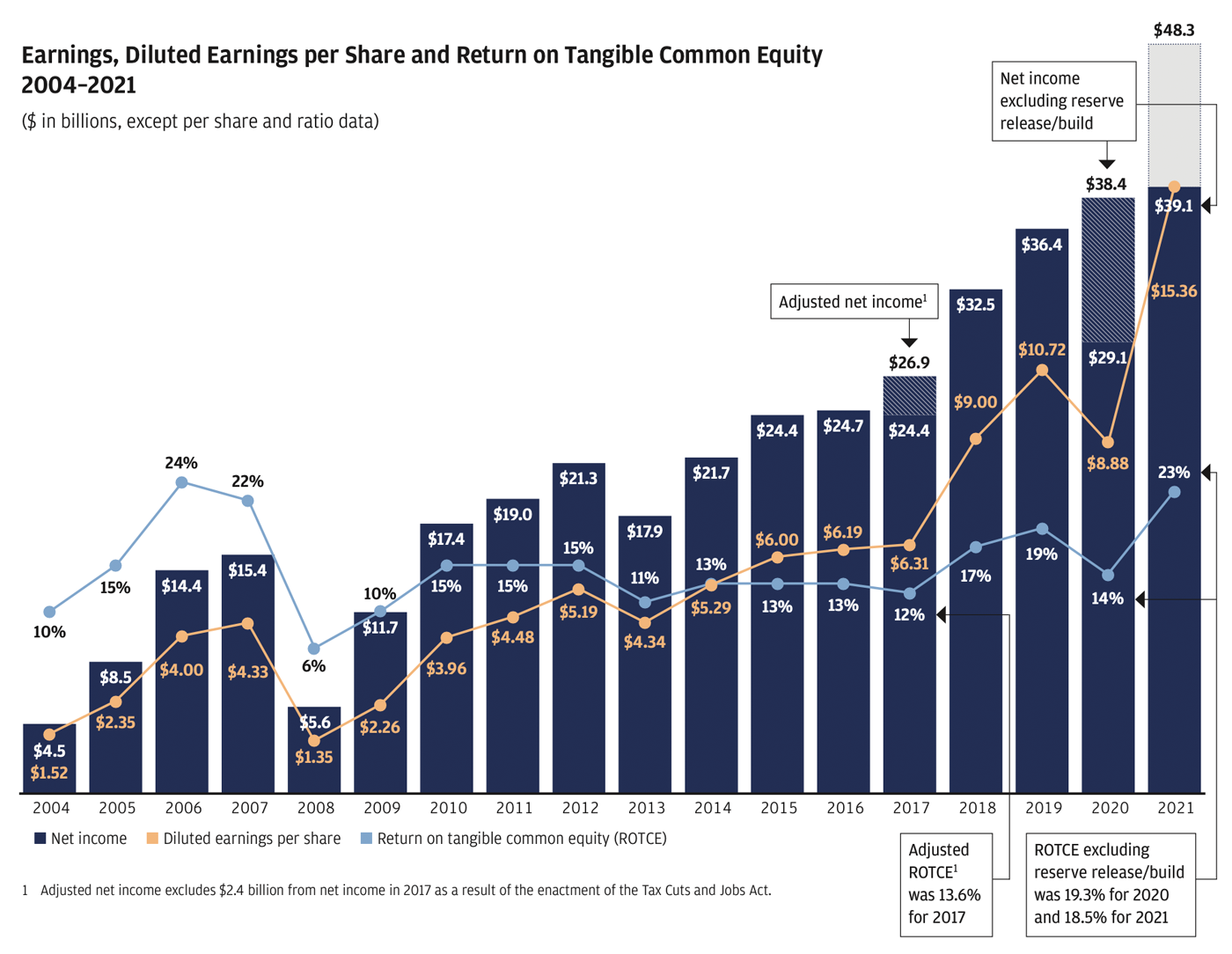

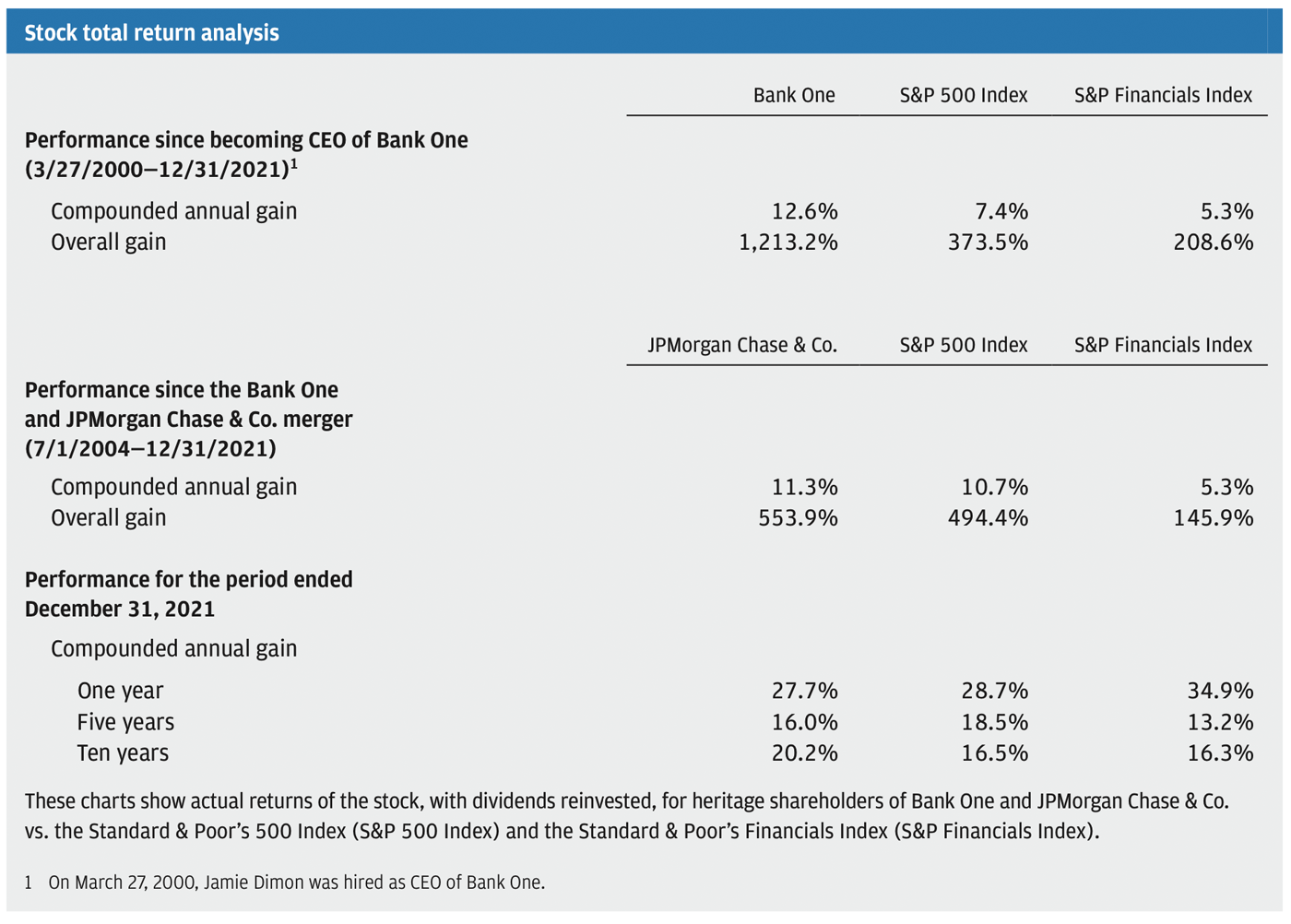
We have consistently described to you, our shareholders, the basic principles and strategies we use to build this company — from maintaining a fortress balance sheet, constantly investing and nurturing talent to fully satisfying regulators, continually improving risk, governance and controls, and serving customers and clients while lifting up communities worldwide.
If you look deeper, you will find that our success and accomplishments are founded on our commitment to our shareholders. Shareholder value can be built only if you maintain a healthy and vibrant company, which means doing a good job taking care of your customers, employees and communities. Conversely, how can you have a healthy company if you neglect any of these stakeholders? As we have learned in 2021, there are myriad ways an institution can demonstrate its compassion for its employees and its communities while still upholding shareholder value.
Adhering to our basic principles and strategies allows us to drive good organic growth and properly manage our capital (including dividends and stock buybacks), as we have consistently demonstrated over the past decades. All of this is shown in the charts below, which illustrate how we have grown our franchises, how we compare with our competitors and how we look at our fortress balance sheet. I invite you to peruse them at your leisure. In addition, I urge you to read the CEO letters in this Annual Report, which will give you more specific details about our businesses and our plans for the future.
There are two other critical points I would like to make. We strive to build enduring businesses, and we are not a conglomerate — all our businesses rely on and benefit from each other. Both of these factors help generate our superior returns. But, despite our best efforts, the moats that protect this company are not particularly deep — and we face extraordinary competition. I have written about this reality extensively in the past and cover it in more detail in this letter. However, it is the hand we have been dealt, and we will play it as best we can.
My friend, Warren Buffett, spoke in his letter this year about his silent partner — the U.S. government — noting that all his company’s success is predicated upon the extraordinary conditions our country creates. He is right to say to his shareholders that when they see the flag, they should all say thank you. We should, too. I do just want to note that in our case, the silent partner is not so silent. JPMorgan Chase is a healthy and thriving company, and we always want to give back and pay our fair share. We do — and we want it to be spent well and have the greatest impact. To give you an idea of where our taxes and fees go: In the last 10 years, we paid $42 billion in federal, state and local taxes in the United States and $17 billion in taxes outside of the United States. We also paid the Federal Deposit Insurance Corporation $11 billion so that it has the resources to cover the failure of any major American bank.
Finally, the basis of our success is our people. They are the ones who serve our customers and communities, build the technology, make the strategic decisions, manage the risks, determine our investments and drive innovation. Whatever your view is of the world’s complexity and the risks and opportunities ahead, having a great team of people — with guts, brains, integrity and enormous capabilities to navigate personally challenging circumstances while maintaining high standards of professional excellence — is what ensures our prosperity, now and in the future.
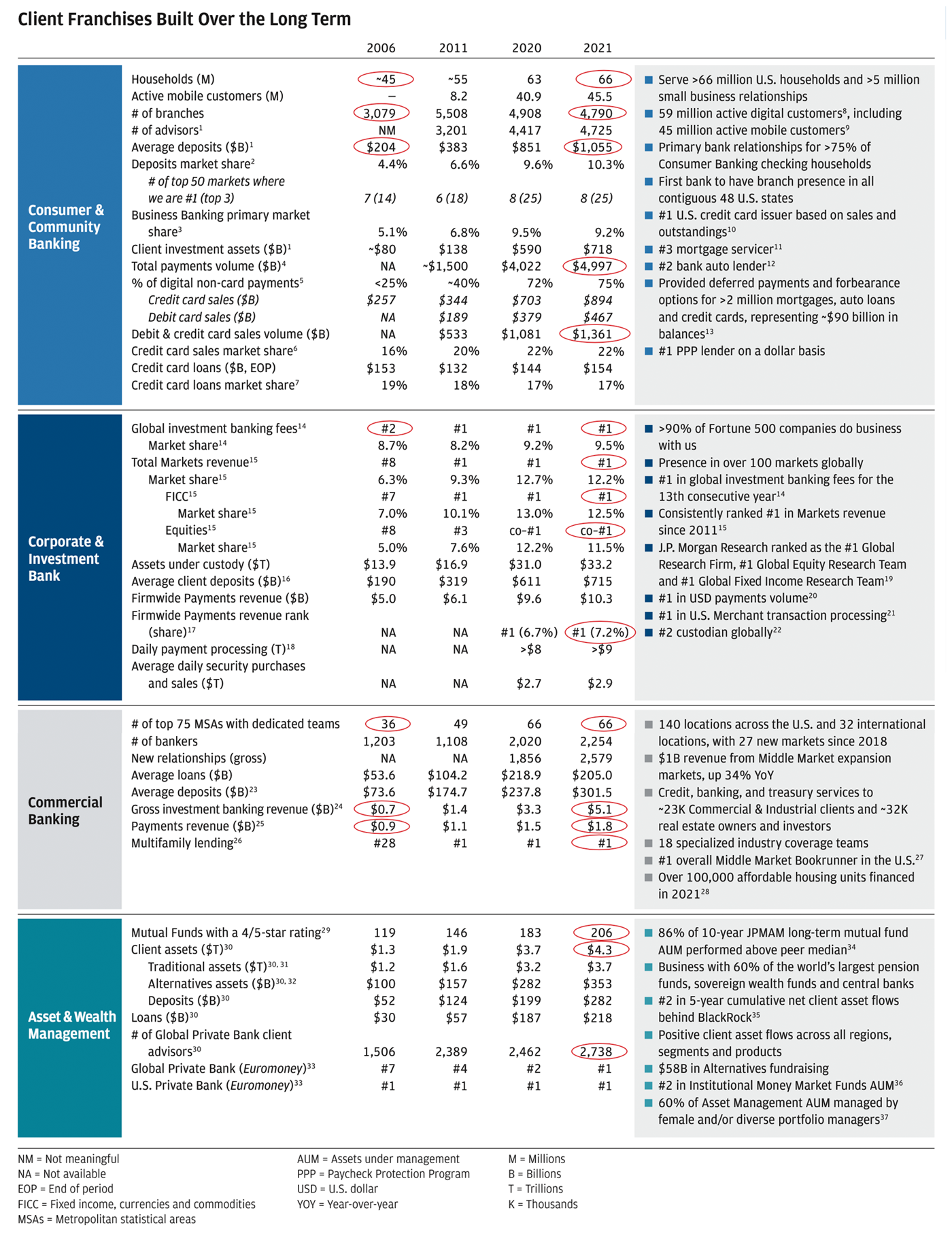
Read footnoted information here


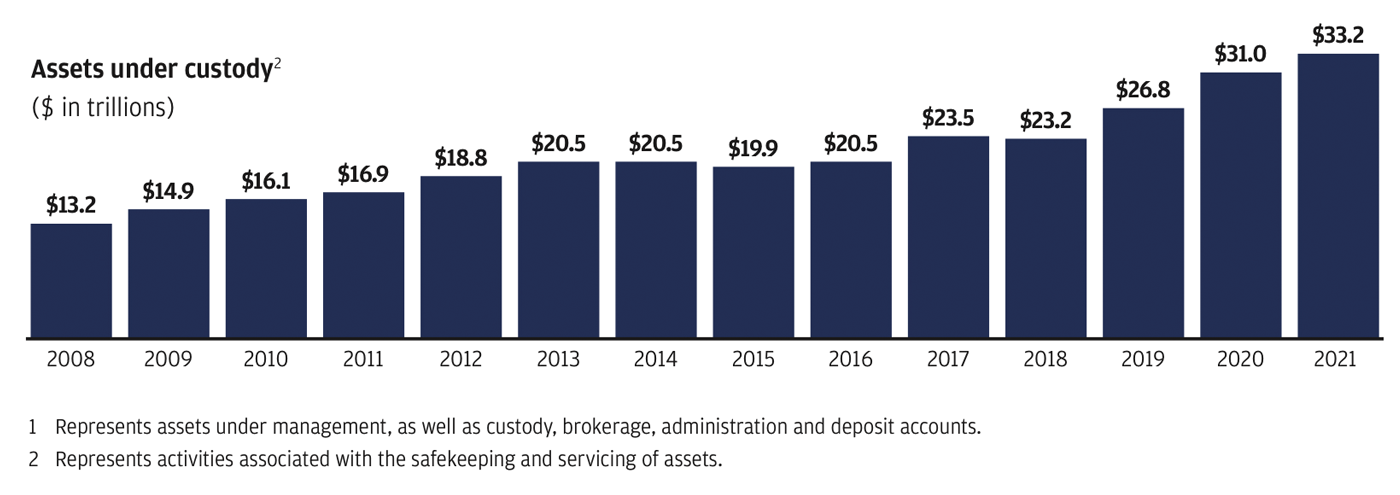

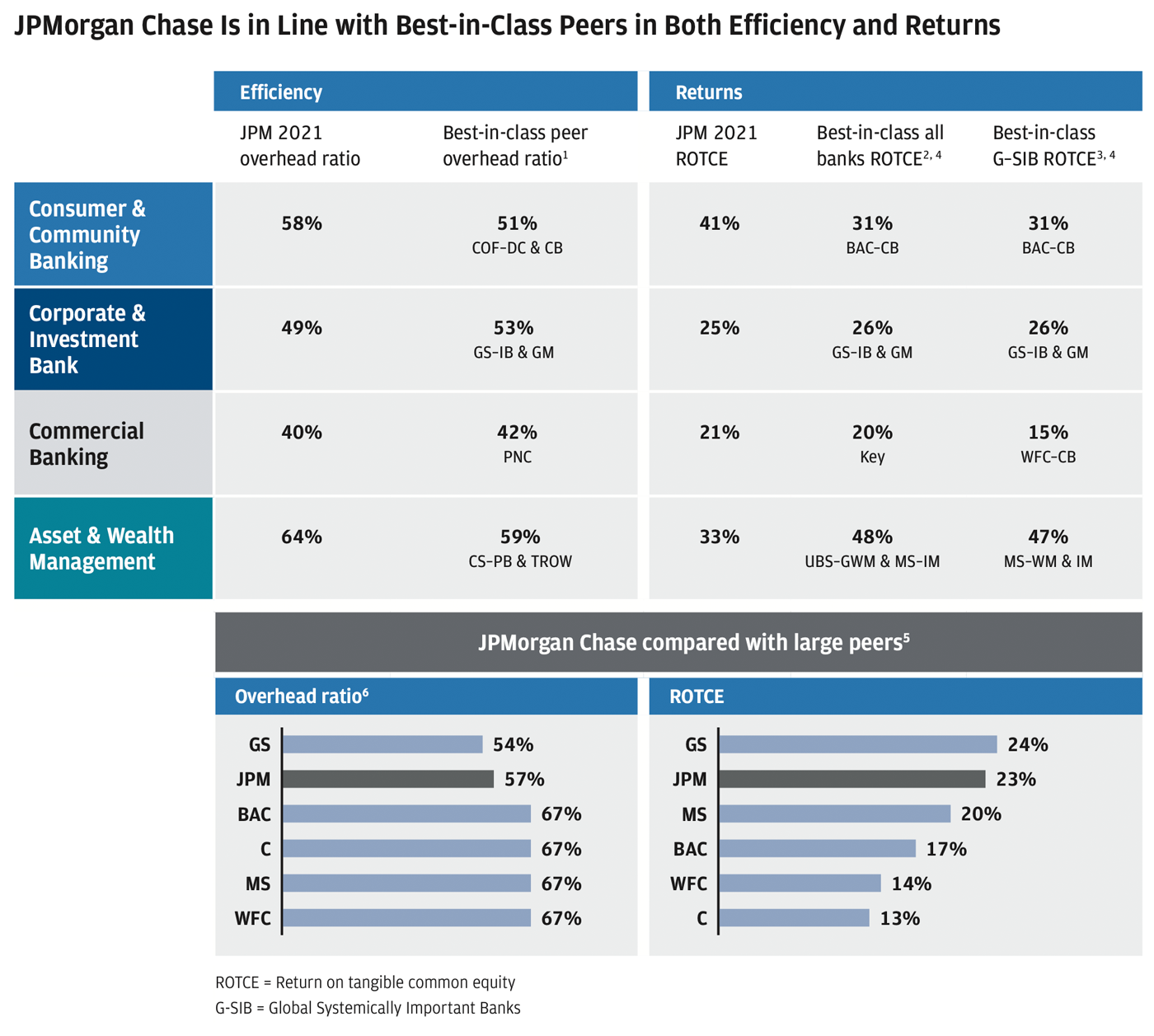
Read footnoted information here
Within this letter, I discuss the following:
Significant Geopolitical and Economic Challenges
- The U.S. economy is strong.
- Persistent inflation will require rising interest rates and a massive but necessary shift from quantitative easing to quantitative tightening.
- The war in Ukraine and the sanctions on Russia, at a minimum, will slow the global economy — and it could easily get worse.
- The confluence of these factors may be unprecedented.
- The war could affect geopolitics for decades.
- How are we managing our global bank in these difficult markets and complex times?
The Extraordinary Need for Strong American Leadership
- While America has flaws, its essential strengths endure.
- To maintain our competitiveness, our country must regain its competence — and our principles, including free enterprise, need to be nurtured.
- Government, with its unique powers, has an essential role in managing the economy — but it needs to be realistic about its limitations on what it can and cannot do.
- We must confront the Russia challenge with bold solutions.
- A strong America need not fear a rising China.
- There are compelling reasons for global trade restructuring.
- We can have a path forward for U.S. policy: Agree on what we want, then execute.
- Banks performed magnificently during the COVID-19 crisis.
- The role of banks in the global financial system is diminishing.
- Possibly more important: The role of public companies in the global financial system is also diminishing.
- More regulation is coming — 10 years after the crisis, we are still rolling out Basel IV — and we need more thoughtful calibration of the rules.
- How should we address our G-SIB conundrum?
- Banks need to acknowledge the dramatically changing competitive landscape.
Investments and Acquisitions: Determining the Best Use of Capital and Assessing ROIs
- Some investments generate predictable returns.
- Acquisitions should pay for themselves — and each one has its own logic.
- We want to build upon our global footprint.
- We make extensive investments in technology for a broad range of reasons, from improving operations and security to enhancing our products and services.
Updates on Specific Issues Facing Our Company
- We are vigilant against cyber attacks.
- Our commitment to sustainability is informed by energy realities.
- Progress continues in our diversity, equity and inclusion efforts.
- Morgan Health is helping us lead in healthcare transformation.
- We continue to support data-driven policymaking through the JPMorgan Chase PolicyCenter and Institute.
- We join other companies in evolving our vision of the workplace.
Management Lesson: The Benefit of Purpose and the Tremendous Value of Work
- Perfect your Picasso — have something to strive for and motivate you.
- Recognize the tremendous value of work.
- Nurture the extraordinary value of trust.
- Combat the enemy within.
- Drive high performance, the right way.
- Retaining talent is important and so is life outside of work.
The full letter can be at https://reports.jpmorganchase.com/investor-relations/2021/ar-ceo-letters.htm
Source: JP Morgan














